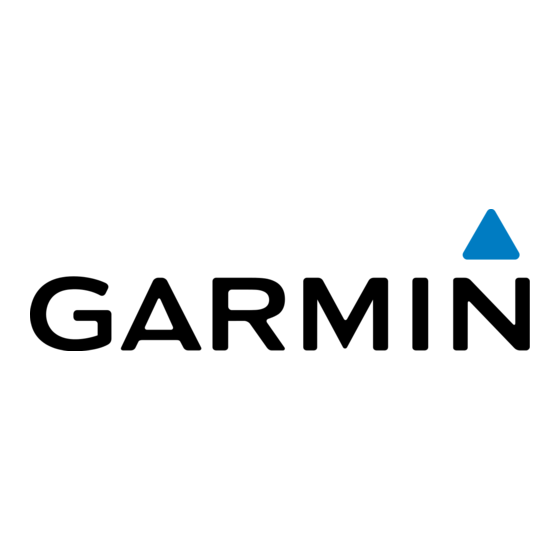Garmin GPSMAP 8000 Series Manual del usuario - Página 40
Navegue en línea o descargue pdf Manual del usuario para Sistema GPS marino Garmin GPSMAP 8000 Series. Garmin GPSMAP 8000 Series 43 páginas. Installation instructions
También para Garmin GPSMAP 8000 Series: Manual del usuario (36 páginas), Manual de inicio rápido (4 páginas), Manual de instrucciones (15 páginas), Manual de instrucciones de instalación (14 páginas)

Setting the Fuel Alarm
Before you can set a fuel level alarm, a compatible fuel flow
sensor must be connected to the NMEA 2000 network.
You can set an alarm to sound when the total amount of
remaining onboard fuel reaches the level you specify.
1
Select Settings > Alarms > Fuel > Fuel Level Alarm > On.
2
Enter the remaining amount of fuel that triggers the alarm.
Setting Weather Alarms
Before you can set weather alarms, you must have a compatible
chartplotter connected to a weather device, such as a GXM
device, and have a valid weather subscription.
1
Select Settings > Alarms > Weather.
2
Turn on alarms for specific weather events.
My Vessel Settings
NOTE: Some settings and options require additional charts or
hardware.
Select Settings > My Vessel.
Keel Offset: Offsets the surface reading for the depth of a keel,
making it possible to measure depth from the bottom of the
keel instead of from the transducer location (Setting the Keel
Offset).
Temperature Offset: Compensates for the water temperature
reading from a NMEA 0183 water-temperature sensor or
a temperature-capable transducer (Setting the Water
Temperature Offset).
Calibrate Water Speed: Calibrates the speed-sensing
transducer or sensor (Calibrating a Water Speed Device).
Fuel Capacity: Sets the combined fuel capacity of all the fuel
tanks on your vessel (Setting the Fuel Capacity of
the Vessel).
Vessel Type: Enables some chartplotter features based on the
boat type.
Setting the Keel Offset
You can enter a keel offset to compensate the surface reading
for the depth of a keel, making it possible to measure depth from
the bottom of the keel instead of from the transducer location.
Enter a positive number to offset for a keel. You can enter a
negative number to compensate for a large vessel that may
draw several feet of water.
1
Complete an action, based on the location of the transducer:
• If the transducer is installed at the water line
the distance from the transducer location to the keel of the
boat. Enter this value in steps 3 and 4 as a positive
number.
• If the transducer is installed at the bottom of the keel
measure the distance from the transducer to the water
line. Enter this value in steps 3 and 4 as a negative
number.
Device Configuration
2
Select Settings > My Vessel > Keel Offset.
3
Select
4
Enter the distance measured in step 1.
Setting the Water Temperature Offset
Before you can set the water temperature offset, you must have
a NMEA 0183 water-temperature sensor or a temperature-
capable transducer to measure water temperature.
The temperature offset compensates for the temperature
reading from a temperature sensor.
1
Measure the water temperature using the temperature sensor
or temperature-capable transducer that is connected to the
chartplotter.
2
Measure the water temperature using a different temperature
sensor or a thermometer that is known to be accurate.
3
Subtract the water temperature measured in step 1 from the
water temperature measured in step 2.
This is the temperature offset. Enter this value in step 5 as a
positive number if the sensor connected to the chartplotter
measures the water temperature as being colder than it
actually is. Enter this value in step 5 as a negative number if
the sensor connected to the chartplotter measures the water
temperature as being warmer than it actually is.
4
Select Settings > My Vessel > Temperature Offset.
5
Enter the temperature offset calculated in step 3.
, measure
Calibrating a Water Speed Device
If you have a speed-sensing transducer connected to the
chartplotter, you can calibrate that speed-sensing device to
improve the accuracy of water-speed data displayed by the
,
chartplotter.
1
Select Settings > My Vessel > Calibrate Water Speed.
2
Follow the on-screen instructions.
If the boat is not moving fast enough or the speed sensor is
not registering a speed, a message appears.
3
Select OK, and safely increase the boat speed.
4
If the message appears again, stop the boat, and ensure the
speed-sensor wheel is not stuck.
5
If the wheel turns freely, check the cable connections.
6
If you continue to get the message, contact Garmin product
support.
Setting the Vessel Type
You can select your boat type to configure the chartplotter
settings and to use features customized for your boat type.
1
Select Settings > My Vessel > Vessel Type.
2
Select Powerboat or Sailboat.
or
based on the location of the transducer.
39
